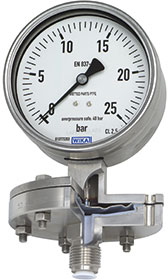

When compared with Bourdon tube gauges, these will always take second place – though where the ‘top seller’ in mechanical pressure measurement technology is reaching its physical limits, diaphragm pressure gauges come into the frame. They are the specialists in the process industry when it comes to critical measuring tasks such as with highly corrosive or viscous media or when it comes to low pressure and also overpressure.
Diaphragm pressure gauges are suitable for gauge, absolute and differential pressure.
Their core, the diaphragm element, is a circular, corrugated diaphragm which is clamped or welded between two flanges. This element is generally manufactured from resilient steels such as stainless steel or Inconel. On pressure loading, the deflection of the element, proportional to the incident pressure, is translated to a movement via a link.
The usable diaphragm travel is as short as approximately one millimetre, which offers a high repeatability. However, this characteristic is related to corresponding standards for quality and tolerances of the diaphragm materials. In addition to the material itself, the material strength, wave form and diameter determine the metrological characteristics of the diaphragm, and with this, the quality of the measuring result for the appropriate measuring range. Diaphragm elements basically possess a corrugated profile. A smooth metal diaphragm would deform plastically under loading and would therefore make a precise pressure measurement impossible.
Set against the Bourdon tube gauge, this ‘colleague’ with a diaphragm measuring element has unique advantages.
Measurement of low pressures
Diaphragm pressure gauges from WIKA measure pressures from 16 mbar, with the maximum value being, on average, about 25 bar. For measuring instruments with Bourdon tubes, in contrast, the lowest measured value achieved is around 600 mbar.
At pressures below 16 mbar however, diaphragm elements are pushed to their limits: they would have to be extremely thin to achieve the requisite elasticity, and would thus no longer be reliably stable. This problem can be solved, though, with a special form of the diaphragm gauge: the capsule pressure gauge. Capsule elements consist of two diaphragms welded together, which are generally loaded with pressure from the inside.
This results in a double tube travel. This means that lower pressures can be measured without a reduction in the wall thickness. Capsule pressure gauges, however, have the disadvantage of more limited fields of application. Since their pressure chamber is not self-draining, they are not suitable for applications with liquid media.
High overpressure safety
Measuring systems with diaphragm elements, on the grounds of their design alone, offer good protection from overpressure, since the diaphragm can support itself against the upper flange. Diaphragm pressure gauges from WIKA, for example, thus have a standard overpressure safety of five times the full scale value with Bourdon tube pressure gauges, this is only around 1.3 times as standard.
The overpressure safety with diaphragm element instruments can still, however, be increased up to one thousand times, up to 400 bar is possible. This holds true, even for measuring ranges up to 16 mbar. In this case, the upper flange has a specially turned, metallic diaphragm bed, into which the diaphragm element seats, should the full scale value be exceeded. Through this full-surface contact, any plastic deformation is excluded and the long-term stability is increased.
Use with critical media
Here, diaphragm pressure gauges offer the user considerable leeway. In order, for example, to make their diaphragms resistant against aggressive substances, a whole multitude of special materials can be exploited from PTFE, via tantalum, Hastelloy or titanium, through to gold. For Bourdon tubes, only stainless steel and Monel are typically suitable.
Depending on the requirements, the diaphragm element has a foil from the special material glued to it, for gold-plating it can also be galvanised. Provided that these materials have the required resilience properties, the pressure element can also be manufactured partially or completely from them. With particularly aggressive media, the lower flange of the diaphragm can also be lined, thus the area in contact with the product is fully protected. For operation in sanitary applications, variants with flush diaphragms are available.
Conclusion
Low measuring ranges, high overpressure safety, special materials for aggressive media, open flanges for viscous media: The versatility of these gauge models in the process industry, demonstrated here, is strongly underlined. Diaphragm pressure gauges are almost predestined for the highest demands of aggressive materials, such as one finds in the chemical and petrochemical industries. They have also been designed for harsh environments in the oil and gas industries: WIKA diaphragm pressure gauges in a standard design (stainless steel or Inconel) are, for example, qualified in accordance with the requirements of NACE 0175 standard, up to a temperature of 120°C, and thus are suitable for sour gas applications. This capability is confirmed through tests from an independent institute.
| Tel: | +27 11 621 0000 |
| Email: | [email protected] |
| www: | www.wika.co.za |
| Articles: | More information and articles about WIKA Instruments |

© Technews Publishing (Pty) Ltd | All Rights Reserved